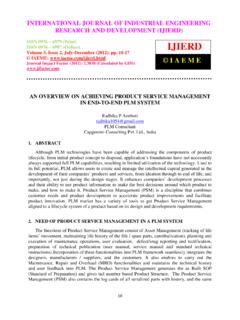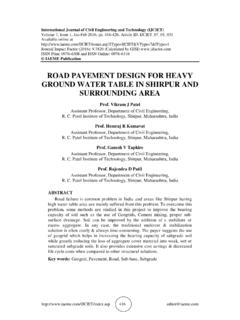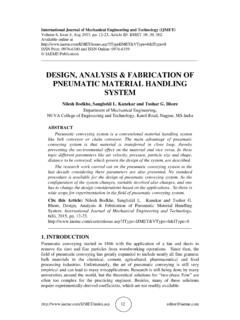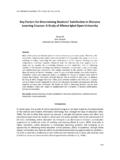Transcription of 34 COMPARATIVE STUDY OF DIFFERENT DIGITAL …
1 International Journal of Electronics and Communication Engineering & Technology (IJECET), ISSN 0976 6464(Print), ISSN 0976 6472( online ), Volume 5, Issue 12, December (2014), pp. 258-265 IAEME 258 COMPARATIVE STUDY OF DIFFERENT DIGITAL INPAINTING ALGORITHMS Sudhir , Professor and Head Electronics and Telecommunication Engineering Department TPCT s College Of Engineering, Osmanabad ( ) India Sandip S. Gujare PG Student Electronics and Telecommunication Engineering Department TPCT s College Of Engineering, Osmanabad, ( ), India ABSTRACT Image inpainting is the process of filling in missing parts of damaged images based on information gathered from surrounding areas. In addition to problems of image restoration, inpainting can also be used in wireless transmission and image compression applications. This paper gives COMPARATIVE STUDY of DIFFERENT Image Inpainting Techniques. The proposed work includes the PDE based inpainting algorithm and Texture synthesis based inpainting algorithm.
2 Keywords: Inpainting, PDE, Texture Synthesis, Image Restoration Isophotes. I. INTRODUCTION Image inpainting refers to the process of filling-in missing data in a designated region of the visual input. The object of the process is to reconstruct missing parts or damaged image in such a way that the inpainted region cannot be detected by a causal observer. Image inpainting has been widely investigated in the applications of DIGITAL effect ( , object removal), image restoration ( , scratch or text removal in photograph), image coding and transmission ( , recovery of the missing blocks), etc. The increase in computing power and disk space over the last few decades has created new possibilities for image and movie post processing Typical damages are scratches or stains in photographs, peeled of coatings, or dust particles burned into celluloid. All these flaws create regions where the original image information is lost. Manual restoration of images or single movie frames is INTERNATIONAL JOURNAL OF ELECTRONICS AND COMMUNICATION ENGINEERING & TECHNOLOGY (IJECET) ISSN 0976 6464(Print) ISSN 0976 6472( online ) Volume 5, Issue 12, December (2014), pp.
3 258-265 IAEME: Journal Impact Factor (2014): (Calculated by GISI) IJECET I A E M E International Journal of Electronics and Communication Engineering & Technology (IJECET), ISSN 0976 6464(Print), ISSN 0976 6472( online ), Volume 5, Issue 12, December (2014), pp. 258-265 IAEME 259 possible, but it is desirable to automate this process. Several Inpainting algorithms have been developed to achieve this goal. They may roughly be divided into two categories: 1. Usually PDE based algorithms are designed to connect edges (discontinuities in boundary data) or to extend level. They are targeted on extrapolating geometric image features, lines in some adequate manner into the inpainting domain. especially edges. They create regions inside the Inpainting domain. Most of them produce disturbing artifacts if the inpainting domain is surrounded by textured regions. 2. Texture synthesis algorithms use a sample of the available image data and aim to fill the inpainting domain such that the color relationship statistic between neighbored pixels matches those of the sample.
4 They aim for creating intra region details. If the inpainting domain is surrounded by differently textured regions, these algorithms can produce disturbing artifacts. In this section we will briefly explain the main ideas and the concepts of some of the existing inpainting algorithms. II. METHODOLOGY Partial Differential Equation (PDE) based Inpainting PDE (partial differential equations) is designed to connect edges or isophotes (line of equal gray values). Bertalmio et al.[1] proposed an image inpainting algorithm based on PDE. Its algorithm will have good results if missed regions are small, but in large damaged regions it will take so long time and won t have good results. Bertalmio et al. [1] use similarities between image processing and fluid dynamic topics, and he proposed an image inpainting algorithm using the Navier Stokes equation. Chan and Shen in [3] use energy functional involving the curvature of the level curves and tries to connect level curves in a smoothing fashion.
5 Masnou and Morel [4] present a new model for image inpainting. They propose a simple but effective algorithm to connect level lines. Telea in [5] propose a fast marching method that can be considered as a PDE method which is faster and simpler to implement than other PDE based algorithms. All of above mentioned algorithms are very time consuming and have some problems with the damaged regions with a large size. PDE technique has been widely used in numerous applications such as image segmentation, restoration and compression. Even for traditional image inpainting. Texture Synthesis Based Inpainting Texture synthesis based algorithms fill in damaged or missed regions using similar neighborhoods in an image, they try to match statistics of damaged regions to statistics of known regions in the neighborhood of damaged pixels. One of the earliest modes of image inpainting was to use general texture synthesis algorithms to complete the missing regions.
6 The texture synthesis algorithms synthesize new image pixels from an initial seed and strive to preserve the local structures of the image. Earlier inpainting techniques utilized these methods to fill the holes by sampling and copying pixels from neighboring areas. For example, Markov Random Field (MRF) is used to model the local distribution of a pixel and new texture is synthesized by querying existing texture and finding all similar neighborhoods. Their differences lay mainly in how continuity is maintained between the inpainted hole and the existing pixels. These synthesis based techniques perform well only for homogenous texture information would result in a natural completion. Later this effort was extended to a fast synthesizing algorithm by stitching together small patches of existing images referred to as image quilting. Heeger and Bergen in [6] developed a parametric texture synthesis algorithm which can synthesize a matching texture, given a target texture.
7 Igehy in [7] included a composition step to the above method to generate synthetic and real textures. A multi-resolution texture synthesis method which can generate texture under varying brightness conditions was introduced for inpainting by Yamauchi in [8]. Recently, a fast multi-resolution based image completion based on texture analysis and synthesis was introduced by Fang in [9]. In their International Journal of Electronics and Communication Engineering & Technology (IJECET), ISSN 0976 6464(Print), ISSN 0976 6472( online ), Volume 5, Issue 12, December (2014), pp. 258-265 IAEME 260 method, the input image was analyzed by a patch based method using Principal Component Analysis (PCA) and a Vector Quantization (VQ) based technique was used to speedup the matching process of the texture inside the hole region. A. Criminisi [10] uses the simultaneous propagation of texture and structure information is achieved by a single, efficient algorithm.
8 There are innumerable texture synthesis methods other than the aforementioned, but we shall restrict ourselves to illustrate those texture synthesis techniques specifically used for inpainting. While the texture synthesis based inpainting perform well in approximating textures, they have difficulty in handling natural images as they are composed of structures in the form of edges and have complex interactions between structure and texture boundaries. In some cases, they also require the user to specify what texture to replace and the place to be replaced. Hence while appreciating the use of texture synthesis techniques in inpainting, it is prudent to understand that these methods address only a small subset of inpainting issues and are not suitable for a wide variety of applications. III. IMAGE INPAINTING ALGORITHMS PDE based Inpainting Algorithm. A Partial Differential Equation (PDE) based iterative algorithm proposed by Bertalmio [1] paved the way for modern DIGITAL image inpainting.
9 Borrowing heavily from the idea of manual inpainting, this iterative process propagates linear structures (edges) of the surrounding area also called Isophotes, into the hole region denoted by using a diffusion process given by (1) One of the main drawbacks of this technique is that it underperforms in the replication of large textured regions due to blurring artifact of the diffusion process and the lack of explicit treatment of the pixels on edges. Inspired by this work, Chan and Shen in [4] proposed the Total Variational (TV) inpainting model which uses Euler-Lagrange equation and anisotropic diffusion based on the strength of the isophotes. The TV model was extended to Curvature Driven Diffusion model (CDD) in which included the curvature information of the isophotes to handle the curved structures in a better manner. Tschumperle [11] introduced another PDE based technique referred to as vector valued regularization under anisotropic diffusion framework.
10 These algorithms were focused on maintaining the structure of the inpainting area and hence could not perform as well in texture flling due to blurring artifacts. Numerical Implementation of the Inpainting Algorithm Input: Image to be inpainted, Mask that delimits the position to be inpainted. Pre-processing step: Whole original image undergoes anisotropic diffusion smoothing. (To minimize the influence of noise on the estimation of the direction of the isophotes arriving at ) Inpainting loop: Repeat the following until a steady state is achieved. (Only values inside are modified) Every few iterations, a step of anisotropic diffusion is applied. I i, j ) =I ( i, j) + t .I (i, j ), (I, j) (1) I i, j = L i, j . , , , , | I i, j | (2) L i, j = L i + 1, j L i 1, j , L i, j + 1 L i, j 1 (3) i, j = I i, j + I i, j (4) International Journal of Electronics and Communication Engineering & Technology (IJECET), ISSN 0976 6464(Print), ISSN 0976 6472( online ), Volume 5, Issue 12, December (2014), pp.















